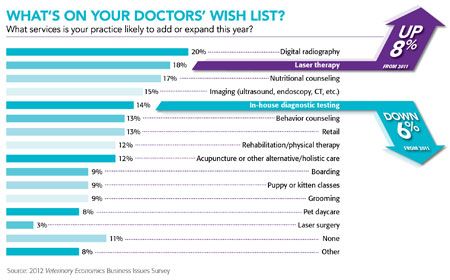Diagnose your diagnostics
Get up-to-date on the diagnostics your veterinary practice offers-and help educate pet owners about the services that can help their pets live longer, healthier lives.
Next >
Whether you’re a certified lab rat or you only duck by the diagnostic parts of the practice on your way to the break room, it’s important to know what goes on there—so you can teach clients the importance of veterinary diagnostics.
As in-house diagnostics have become more affordable, Firstline Editorial Advisory Board member Ciera Miller, CVT, says more practices than ever are adding equipment to run diagnostics, such as common hematology and serology tests. “This means cheaper costs for clients, which is often a barrier to approving diagnostics for their pets,” Miller says. “Clients also seem to be more satisfied when they hear they only need to wait 15 to 20 minutes for blood work instead of two to three days. Most important, the pets waiting for accurate, prompt treatment benefit from the quick results.”
Depending on your practice’s size and type, it may also offer larger diagnostic machines, from digital radiography to CT scanners. “Many pet owners are surprised that they can have most diagnostics in-house within their scheduled appointment time,” Miller says.

How-to tip: Show and tell
If your practice takes digital dental radiographs, this offers an opportunity to show value, says Firstline board member Kyle Palmer, CVT. During the discharge process, Palmer recommends a comprehensive review of radiographs. This helps validate your treatment in a way that wasn’t possible a few years ago, he says.
“I still remember the look of suspicion in pet owners’ eyes as we outlined the teeth extracted. I know some of them wondered if we did this to generate extra revenue,” he says. “Those days are gone, as even the most conservative pet owner can see firsthand what her dog or cat was living with in its mouth.”
To overcome objections to dental radiographs, consider these tips:
1. Show the pet owner examples of other pets’ films to demonstrate their value.
2. Use a smart pricing approach. Palmer says his practice opts to charge a little less and makes up for it with the extra treatments they identify. You can also include them as part of a package to overcome client objections.
How-to tip: Don’t judge
With the amazing technology available to provide pets with topnotch pet care, it can be frustrating when pet owners decline the diagnostics your veterinarian recommends. But Firstline board member Ciera Miller, CVT, says it’s important to avoid judging pet owners who can’t afford tests—especially when the doctor recommends multiple diagnostics.
“The veterinarian can help by finding a compromise to prioritize which tests the pets need and the pet owners can afford,” Miller says. “The hospital team can also help by preparing clients for these costs with accurate estimates. Clients are more likely to approve tests if they’ve had enough time to prepare for the cost and find ways to afford the recommended diagnostics.”